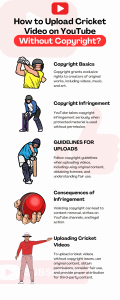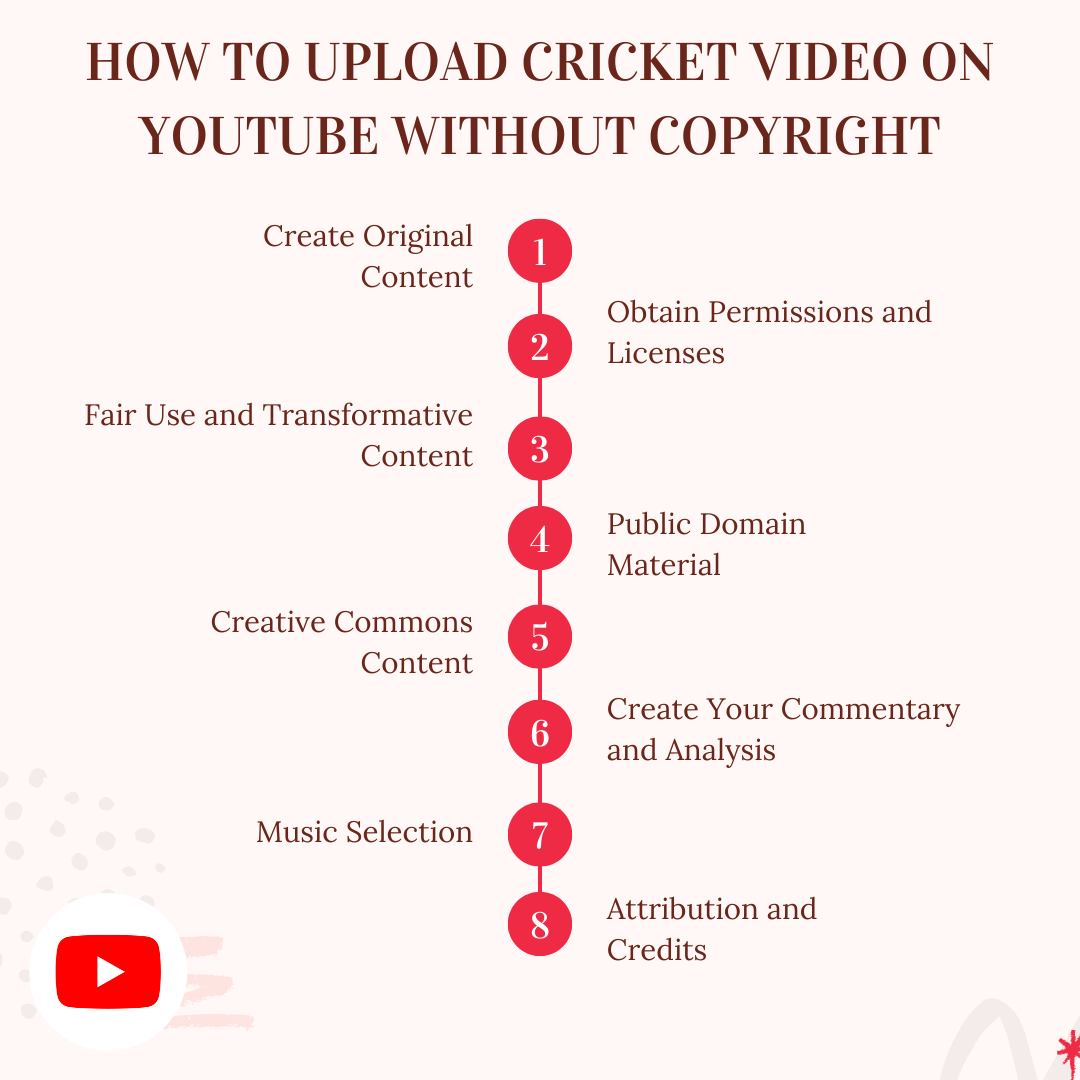Introduction
YouTube has become one of the most popular platforms for sharing videos and creative content. However, uploading videos on YouTube requires understanding and adherence to copyright laws and concepts. This note aims to provide a well-researched guide on uploading videos to YouTube while respecting copyright regulations. So, How to Upload Cricket Video on YouTube Without Copyright? Let’s check!
Understanding Copyright
Copyright is a legitimate idea that awards elite freedoms to makers and proprietors of unique works, like recordings, music, writing, and artistry. These privileges incorporate the power to recreate, disperse, show, and play out the work and the option to do subordinate works given the first.
Copyright Infringement on YouTube
YouTube profoundly treats copyright Infringement and has carried out different measures to safeguard the privileges of content makers. Copyright Infringement happens when somebody utilizes protected material without getting consent from the copyright holder or without falling under a legitimate special case, like fair use.
Uploading videos on YouTube:
While uploading recordings on YouTube, creators should guarantee that their content consents to copyright guidelines. Here are a few key contemplations:
1) Original Substance:
Make and transfer recordings that are your own or that you have been authorized to utilize. Utilizing protected material without consent can bring about satisfactory evacuation or lawful outcomes.
2) Licensed Material:
To involve protected material in your recordings, get the licenses or authorizations from the copyright holder. This applies to music, film clasps, pictures, and other protected material highlighted in your video.
3) Fair Use:
Fair use is a legitimate precept that permits restricted utilization of protected material without consent in specific situations. Factors considered for fair use incorporate the reason and character of the utilization, the idea of the protected work, the sum utilized, and the impact available. Nonetheless, fair use is a complex and explicit idea, and deciding fair use can be emotional.
4) Creative Hall:
Innovative House licenses give a scope of consent that makers can concede to others for utilizing their work. If you wish to utilize Imaginative Center-authorized material, try to conform to the particular terms of the permit, like attribution prerequisites.
5) Public Space:
Public-area works are not safeguarded by copyright and can be unreservedly utilized by anybody. Nonetheless, be careful, as certain works might have exact circumstances or limitations regardless of whether they are in a public space.

how to upload cricket videos on YouTube without copyright free
Outcomes of Copyright Infringement:
The inability to regard copyright guidelines can have a few outcomes, including:
a) Content Expulsion:
YouTube has a Substance ID framework that outputs transferred recordings for protected material. If a match is found, the copyright proprietor can decide to hinder, quiet, or adapt the video, or they might document a copyright guarantee bringing about its expulsion.
b) Copyright Strikes:
Rehashed copyright encroachments can prompt copyright strikes on a YouTube channel. If a channel gets numerous strikes, it might have to deal with damages, for example, constraints on channel highlights, suspension, or end.
c) Legitimate Activity:
Copyright holders reserve the privilege to seek after lawful activity against people or elements that infringe upon their freedoms. This can bring about fights in court, fines, and harm.
Thus, Aspiring YouTube creators and users should be aware of copyright concepts and the implications of uploading videos that violate copyright regulations. By creating original content, obtaining licenses, respecting fair use, and understanding Creative Commons and public domain works, creators can navigate the YouTube platform while honoring copyright laws. It is crucial to remain up-to-date with copyright policies and seek legal advice when uncertain about specific situations to avoid copyright infringement and its potential consequences.
Sharing a cricket video on YouTube without copyright
Sharing cricket videos on YouTube can be a great way to showcase your passion for the sport and engage with a wider audience. However, uploading cricket videos without infringing on copyright laws is essential. This note aims to provide a well-researched guide on uploading a cricket video on YouTube while respecting copyright regulations.
a) Create Original Content:
Creating original cricket video content is the most effective way to avoid copyright infringement. Film your gameplay, practice sessions, or analysis, ensuring that you are the creator and sole owner of the footage.
b) Obtain Permissions and Licenses:
If you want to use copyrighted content in your cricket video, such as clips from professional matches or highlights, it is crucial to obtain the necessary permissions and licenses from the copyright holders., This may involve contacting the relevant cricket boards, broadcasters, or content owners to request usage rights.
c) Fair Use and Transformative Content:
Under the fair use doctrine, limited use of copyrighted material may be permissible, depending on the purpose and nature of the use. Consider if your cricket video falls under fair use by applying commentary, criticism, educational value, or transformative elements that add new meaning or context to the original content. However, fair use can be a complex legal concept, so it is advisable to seek legal advice if you need more certainty.
d) Public Domain Material:
Look for cricket-related content in the public domain. Common domain works are not protected by copyright and can be freely used. However, be cautious, as certain elements within public domain works (such as commentary or music) may still be copyrighted, requiring permission for their use.
e) Creative Commons Content:
Search for cricket footage or related media licensed under Creative Commons. Creative Commons licenses allow creators to grant specific permissions for others to use their work. Ensure understanding and compliance with the specific terms of the Creative Commons license, such as attribution requirements.
f) Create Your Commentary and Analysis:
Adding commentary, analysis, or insights to cricket footage can help make your video more unique and transformative. By focusing on your original thoughts and observations, you can enhance the value of your video and minimize the risk of copyright infringement.
g) Music Selection:
If you plan to include music in your cricket video, ensure you have the right to use the music or choose from a royalty-free music library. Many websites and platforms offer copyright-free or royalty-free music that can be used without infringing copyright laws.
h) Attribution and Credits:
When using any content that is not entirely your own, provide proper attribution and credit to the copyright holders or creators; this includes mentioning their names, the source of the content, and any relevant copyright information.
Therefore, by following these guidelines, you can upload cricket videos on YouTube while respecting copyright laws and avoiding infringement. Remember to create original content, obtain necessary permissions or licenses when using copyrighted material, consider fair use and transformative content principles, and properly attribute any third-party content. Staying informed about copyright regulations and seeking legal advice when in doubt will help ensure your cricket videos are compliant and enjoyable for your audience.

